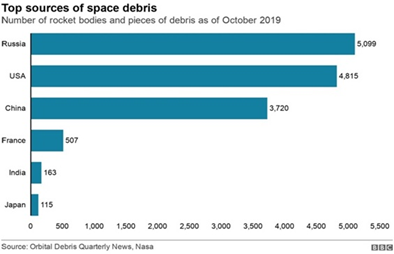

1st August 2023 (6 Topics)
Context
According to the Australian Space Agency, recently found object on Australian shore has been confirmed to be the debris of an Indian Space Research Organisation (ISRO) rocket.
- ISRO has agreed with the assessment, saying the debris could be from one of its Polar Satellite Launch Vehicle (PSLV) rockets.
What is Space Junk?
- Space debris is the thousands of fragments from old rocket parts or disintegrated satellites that litter space - principally in Earth's orbit.
- There are more than 23,000 pieces of debris larger than 10cm (4in) and the US Space Surveillance Network tracks most of them, according to NASA’s Orbital Debris Programme Office (ODPO).
- Most of that debris is zipping around within 1,250 miles of the Earth's surface, along with more than 2,000 artificial satellites, as well as the International Space Station.
About the Scenario:
- Earth's orbit is becoming more congested, with thousands of satellites in operation and more launches planned, increasing the likelihood of a collision.
- But there is no regulation against these anti-satellite tests.
Existing Framework:
Convention on International Liability for Damage Caused by Space Objects:
- There are international regulations governing space debris, which include junk falling back on the earth.
- Most space-faring countries are signatories to the Convention on International Liability for Damage Caused by Space Objects.
- This convention is one of the several international agreements that complement the Outer Space Treaty, the overarching framework guiding the behaviour of countries in space.
- The Liability Convention deals mainly with damage caused by space objects to other space assets, but it also applies to damage caused by falling objects on earth.
- The Convention makes the launching country “absolutely liable” to pay compensation for any damage caused by its space object on the earth or to a flight in air.
- The country where the junk falls can stake a claim for compensation if it has been damaged by the falling object.
|
Outer Space Treaty: ·The OST contains the basic rules that define the behaviour of States in conducting activities in outer space and has resulted in more than sixty years of peaceful cooperation in space that benefits humankind as a whole. ·The Treaty declares outer space “the province of mankind”. This means that its exploration and use shall benefit all countries, be without discrimination, and ensure free access to planets and other celestial bodies. |
UNCOPUOS (1958):
- The UNCOPUOS was established in 1958 as an ad hoc committee of the UN (later made permanent in 1959) with the UN Office for Outer Space Affairs (UNOOSA) as its secretariat.
- UNCOPUOS oversees the implementation of five UN treaties related to outer space activities, namely, Treaty on Principles Governing the Activities of States in the Exploration and Use of Outer Space, including the Moon and Other Celestial Bodies of 1967 (Outer Space Treaty);
- Agreement on the Rescue of Astronauts
- The Return of Astronauts and the Return of Objects launched into Outer Space of 1968 (Rescue Agreement),
- Convention on International Liability for Damage Caused by Space Objects of 1972 (Liability Convention),
- Convention on Registration of Objects Launched into Outer Space of 1976 (Registration Convention)
- the Agreement Governing the Activities of States on the Moon and Other Celestial Bodies of 1979 (Moon Treaty)
- It also oversees other related international agreements like the;
- Treaty Banning Nuclear Weapon Tests in the Atmosphere, in Outer Space, and Under Water (NTB) of 1963
- the Brussels Convention Relating to the Distribution of Programme–Carrying Signals Transmitted by Satellite (BRS) of 1979

How much is India responsible for?
- India still produces much less space junk than the top three polluters: Russia, the US, and China, according to ODPO data.
- Indian-made space debris, however, is on the rise - from 117 pieces in 2018 to 163 in 2019.
What is being done to tackle space debris?
- Several countries, and some private companies, are testing new ways to mitigate space debris, ranging from harpoons, giant magnets, and nets.
- And in 2025, the European Space Agency will launch the first space mission to remove debris from Earth's orbit.
- But NASA says cleaning up the space environment remains a "technical and economic challenge".
More Articles


